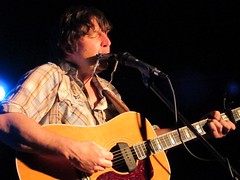Who do Buffalo Killers they think they are?
2.75/5.0


 On the one hand, it's good that Buffalo Killers are so full of ideas that they're compelled to drop a second release within the same year. It's a bonus for their fans and it generates a fresh round of attention. For the most part, reviewers have been kind, so it's paid off, but I can't help but feel let down. To be fair, these six songs aren't bad at all. Instead, the problem is that they're so disjoint. EPs are usually a grab bag, but Fireball of Sulk comes across as an insecure demo for a less competent band trying to find something that will stick.
On the one hand, it's good that Buffalo Killers are so full of ideas that they're compelled to drop a second release within the same year. It's a bonus for their fans and it generates a fresh round of attention. For the most part, reviewers have been kind, so it's paid off, but I can't help but feel let down. To be fair, these six songs aren't bad at all. Instead, the problem is that they're so disjoint. EPs are usually a grab bag, but Fireball of Sulk comes across as an insecure demo for a less competent band trying to find something that will stick.
On a full length album, Buffalo Killers might have been able to create enough context where the playlist could flow more smoothly, but Fireball of Sulk never finds a center. Despite the consistency of their guitar tone, bass grind, and laid back rhythms, they set up two cross currents that break up any momentum that might develop. In particular, the slogging classic metal sound of "Marshmallow Mouth" is optimally placed to break the EP's stride. Its closest sonic cousin on the album is the angst-free grunge of the opening track, "Blankets on the Sun", but rather than accentuating that connection, they crammed it in between a twangy bit of psychedelia ("Weird One") and a '70s style folk rock tune ("Something Else"). This gives it a jarring impact but doesn't serve any of the songs well. To further muddy the water, they double down on the country rock vibe with "Don't Cry to Me", whose choppy cut-time beat recalls Mike Nesmith and the Monkees novelty country work like "Your Auntie Grizelda".
Understand, neither the grunge nor the country rock sounds are objectionable; in fact there's plenty to like about each. Despite being the pitfall of the playlist, "Marshmallow Mouth" is probably my favorite track here. The headbanging snarl of bass and guitar sets up a trudging grind that sways through some two-chord changes to lay the perfect foundation for the flailing guitar solos. It's a thick morass of garage metal, but it's so easy to surrender to the inevitability of the rhythmic tide. The lyrics don't make a lot of sense beyond the accusatory tone of the vocals, but they avoid easy parody, unlike a lot other bands working the same vein.
By contrast, "Something Else" could have easily fit on 2012's Dig. Sow. Love. Grow., with the same unselfconscious retro aesthetic and vocal harmonies that would be at home in the James Gang. In contrast to "Marchmallow Mouth", the autobiographical feel of the lyrics offer a sincere sense of where the band is at. More importantly, Buffalo Killers show an intuition for flow that is missing from the larger picture. The verses settle into a solid wall of guitar, punctuated by the tom hits, but they throw in rhythmic breaks on the lines, "If this life's a game, then have I lost?/ Do I have to dance to pay the cost?" that match the questioning mood and disrupt the sing-song feel of the earlier lines. Later, they use a repeated guitar figure to build up momentum for the Joe Walsh style solo.
In a shuffled iTunes-driven world, it may not really matter. People can pick and choose what they like from Fireball of Sulk and be perfectly happy. For that matter, it's easy enough to jiggle the playlist for some improvement. I'd rather hold out for their next full-length, though, in hopes of a more coherent sense of the band.
2.75/5.0



 On the one hand, it's good that Buffalo Killers are so full of ideas that they're compelled to drop a second release within the same year. It's a bonus for their fans and it generates a fresh round of attention. For the most part, reviewers have been kind, so it's paid off, but I can't help but feel let down. To be fair, these six songs aren't bad at all. Instead, the problem is that they're so disjoint. EPs are usually a grab bag, but Fireball of Sulk comes across as an insecure demo for a less competent band trying to find something that will stick.
On the one hand, it's good that Buffalo Killers are so full of ideas that they're compelled to drop a second release within the same year. It's a bonus for their fans and it generates a fresh round of attention. For the most part, reviewers have been kind, so it's paid off, but I can't help but feel let down. To be fair, these six songs aren't bad at all. Instead, the problem is that they're so disjoint. EPs are usually a grab bag, but Fireball of Sulk comes across as an insecure demo for a less competent band trying to find something that will stick.On a full length album, Buffalo Killers might have been able to create enough context where the playlist could flow more smoothly, but Fireball of Sulk never finds a center. Despite the consistency of their guitar tone, bass grind, and laid back rhythms, they set up two cross currents that break up any momentum that might develop. In particular, the slogging classic metal sound of "Marshmallow Mouth" is optimally placed to break the EP's stride. Its closest sonic cousin on the album is the angst-free grunge of the opening track, "Blankets on the Sun", but rather than accentuating that connection, they crammed it in between a twangy bit of psychedelia ("Weird One") and a '70s style folk rock tune ("Something Else"). This gives it a jarring impact but doesn't serve any of the songs well. To further muddy the water, they double down on the country rock vibe with "Don't Cry to Me", whose choppy cut-time beat recalls Mike Nesmith and the Monkees novelty country work like "Your Auntie Grizelda".
Understand, neither the grunge nor the country rock sounds are objectionable; in fact there's plenty to like about each. Despite being the pitfall of the playlist, "Marshmallow Mouth" is probably my favorite track here. The headbanging snarl of bass and guitar sets up a trudging grind that sways through some two-chord changes to lay the perfect foundation for the flailing guitar solos. It's a thick morass of garage metal, but it's so easy to surrender to the inevitability of the rhythmic tide. The lyrics don't make a lot of sense beyond the accusatory tone of the vocals, but they avoid easy parody, unlike a lot other bands working the same vein.
By contrast, "Something Else" could have easily fit on 2012's Dig. Sow. Love. Grow., with the same unselfconscious retro aesthetic and vocal harmonies that would be at home in the James Gang. In contrast to "Marchmallow Mouth", the autobiographical feel of the lyrics offer a sincere sense of where the band is at. More importantly, Buffalo Killers show an intuition for flow that is missing from the larger picture. The verses settle into a solid wall of guitar, punctuated by the tom hits, but they throw in rhythmic breaks on the lines, "If this life's a game, then have I lost?/ Do I have to dance to pay the cost?" that match the questioning mood and disrupt the sing-song feel of the earlier lines. Later, they use a repeated guitar figure to build up momentum for the Joe Walsh style solo.
In a shuffled iTunes-driven world, it may not really matter. People can pick and choose what they like from Fireball of Sulk and be perfectly happy. For that matter, it's easy enough to jiggle the playlist for some improvement. I'd rather hold out for their next full-length, though, in hopes of a more coherent sense of the band.

 It’s taken six years but
It’s taken six years but 
 Jason Molina was more comfortable faintly disguising his solo work with band names like Songs: Ohia and later Magnolia Electric Co. Whether that helped or hindered, he still managed to inspire a mythology as a tortured artist, an iconoclast and an idiosyncratic genius. Molina himself seemed to have little interest in that kind of analysis; he’d rather buckle down and move on to the next project. Journey On: Collected Singles gathers a number of his early 7″ singles and split sides in lovingly retrospective homage. Ben Swanson of Secretly Canadian talks about how hard it was to get Molina to agree to the idea. He jokes that Molina started to entertain the idea because he was sick of them asking, but of course it may be that he was physically just too sick to argue any more. His untimely death in March 2013 at 39 closed out a long struggle with alcoholism and left fans feeling the loss. This special box set honors the 7” release format he favored. Coming out about for 2014′s Record Store Day some 13 months after he died, it forces a kind of maudlin nostalgia that Molina probably would have resisted.
Jason Molina was more comfortable faintly disguising his solo work with band names like Songs: Ohia and later Magnolia Electric Co. Whether that helped or hindered, he still managed to inspire a mythology as a tortured artist, an iconoclast and an idiosyncratic genius. Molina himself seemed to have little interest in that kind of analysis; he’d rather buckle down and move on to the next project. Journey On: Collected Singles gathers a number of his early 7″ singles and split sides in lovingly retrospective homage. Ben Swanson of Secretly Canadian talks about how hard it was to get Molina to agree to the idea. He jokes that Molina started to entertain the idea because he was sick of them asking, but of course it may be that he was physically just too sick to argue any more. His untimely death in March 2013 at 39 closed out a long struggle with alcoholism and left fans feeling the loss. This special box set honors the 7” release format he favored. Coming out about for 2014′s Record Store Day some 13 months after he died, it forces a kind of maudlin nostalgia that Molina probably would have resisted. As the famous phrase goes, some men just want to watch the world burn, not necessarily out of malevolence, but sometimes because they never let themselves hope for anything more. On
As the famous phrase goes, some men just want to watch the world burn, not necessarily out of malevolence, but sometimes because they never let themselves hope for anything more. On  It’s a dualistic world; every entity contains its own ideal as well
as its negation. Normally one eclipses the other, yielding success or
failure. On This Yesterday Will Never End,
It’s a dualistic world; every entity contains its own ideal as well
as its negation. Normally one eclipses the other, yielding success or
failure. On This Yesterday Will Never End,  Like a stone dropped into inky black waters, there’s no recourse but
to surrender and sink into
Like a stone dropped into inky black waters, there’s no recourse but
to surrender and sink into 

 It's been
It's been 
 Duos are often more revealing than a full band. In a larger group, one member's vision can dominate. Or, by contrast, the personalities can smear together into an amalgamation without the rough edges. But a duo often presents a yin yang balance between two equals. If the match is close, it may emphasize the common ground, but magic can happen when two stronger visions come together. If the clash is not destructive, two perspectives can yield a rich sense of depth.
Duos are often more revealing than a full band. In a larger group, one member's vision can dominate. Or, by contrast, the personalities can smear together into an amalgamation without the rough edges. But a duo often presents a yin yang balance between two equals. If the match is close, it may emphasize the common ground, but magic can happen when two stronger visions come together. If the clash is not destructive, two perspectives can yield a rich sense of depth.









 If there's a brief summary for the characters in
If there's a brief summary for the characters in 




